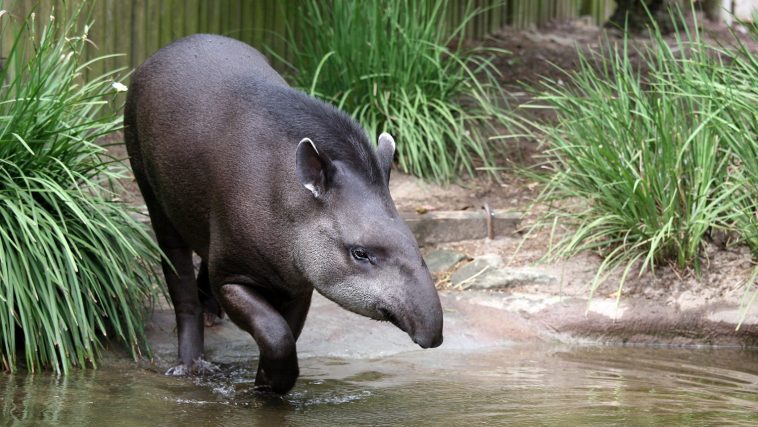[Originally published as Tapirs, Endangered or Hardy Survivors?]
World Tapir Day is coming soon. Since 2008, World Tapir Day has been celebrated annually on April 27th. Although the tapir is its own animal kind, it is similar to a wild pig. In contrast to today’s rather small distribution, tapir fossils are found all over the world.
The tapir is used to help spread awareness of climate change, loss of habitat, and the many other ways humans are harming this earth and its animal inhabitants. And I totally agree. Humans caused climate change, loss of habitat and the total destruction of earth’s animal inhabitants, but not in the way that it is being touted today.
First we will look at today’s typical perspective.
The top portion of the geological column is a necessary reference tool for names and dates. Jurassic is the familiar age of the dinosaur. Tapirs magically appeared about 30 million years later during the Eocene and then defied evolution by remaining unchanged for the next 35 million years. They somehow survived and thrived through many vast extinction events only to suddenly disappear from most of the world, presumably due to climate change and more recently – man.
Today the secular scientists are quick to point to climate change and man as being the cause of mammal endangerment. They point to the prolific amount of tapir fossil on nearly every continent and say tapirs are a prime example of an endangered mammal. The fossils prove they used to live all over the world.
Now due to climate change and man their population has shrunk to four isolated locations:
- Tropical South America
- Southern Mexico and Central America
- the Andes mountain range of South America
- the Thailand peninsula to the island of Sumatra.
Rather than paraphrase, I will let the evolutionists speak for themselves. As you read through these excerpts from Scientific American, pay attention to the many admittedly unanswered questions:
Tapirus is known from the Miocene onward and more than 15 extinct species are currently recognized. Because these species appear more or less simultaneously in North America, Europe and Asia, the origins of Tapirus are somewhat murky.
“The group repeatedly disappears and reappears, apparently as a consequence of local extinction followed by reinvasion from elsewhere. Indeed, there is a so-called ‘tapir vacuum’ just after the Lower Miocene that is soon filled (Van der Made & Stefanovic 2006). European tapirs then persisted across the Miocene-Pliocene boundary.”
Several especially big tapirs are known from the Upper Miocene, Pliocene and Pleistocene of eastern Asia. The biggest of these were similar in size to mid-sized rhinos
“South American tapirs were long assumed to have invaded the continent following the closure of the Panamanian Isthmus during the Late Pliocene. The presence of Upper Miocene tapirs in the Amazon Basin shows, however, that the group reached the continent somewhat earlier…”
How did the tapirs come into South America if the Panamanian Isthmus bridge had not yet formed? Gray’s Fossil Site in Gray, Tennessee has become another famous location of tapir fossils, these are believed to be from the Miocene. Tapirs, along with alligators, rhinos, saber tooth cats and mastodons have been found in the clay pits. Even the remains of a red panda have recently been discovered.
The Rancho La Brea Tar Pits of Los Angeles, California contains another huge collection of fossils. Many groups are still alive today, such as coyotes, mountain lions, woodrats, bats, shrews, rabbits, black bears, and raccoons. Others, they say, went extinct during the Late Pleistocene including: giant ground sloths, saber-toothed cats, mastodons, mammoths, tapirs, camels, and horses.
My question is if sloths, mastodons, mammoths, tapirs, camels and horses once roamed across North America, how did they all go extinct? Perhaps there is another interpretation for the mass destruction so evident in the fossil record. I believe humans have caused climate change, loss of habitat and the total destruction of earth’s animal inhabitants, not over millions of years, but by man’s rebellion against his Creator. God wiped man off the face of the earth with a Global Flood. The Flood destroyed the earth, changed earth’s climate, and buried or froze the remains of the drowned animals.
When viewed from this biblical perspective, a totally different picture emerges
Millions of tapirs, like all other land mammals, died during the flood and were fossilized. Their remains are found in mixed mounds with so many other mammals, because during the flood their bodies bloated and floated then currents and wind collected them into islands of carcasses. Later they were beached on the rising continents and buried by mudflows and volcanic ash. Perhaps the tar and oil at the La Brea Tar Pits is actually from their decomposed bodies.
Considering how, according to the Bible, there were only two survivors on the ark, today’s tapir populations grew from those two survivors. They must have been usefully to man for leather and meat, so were kept in herds during the post flood period. Then as man migrated from the Tower of Babel, they were transported to different locations. Rather than man causing their endangerment, they actually kept them from extinction and transported them around the globe.
So, the present day distribution of mammals can either be used as evidence of endangerment by climate change and man or as post flood re-population after the mass destruction of life during the global flood.







